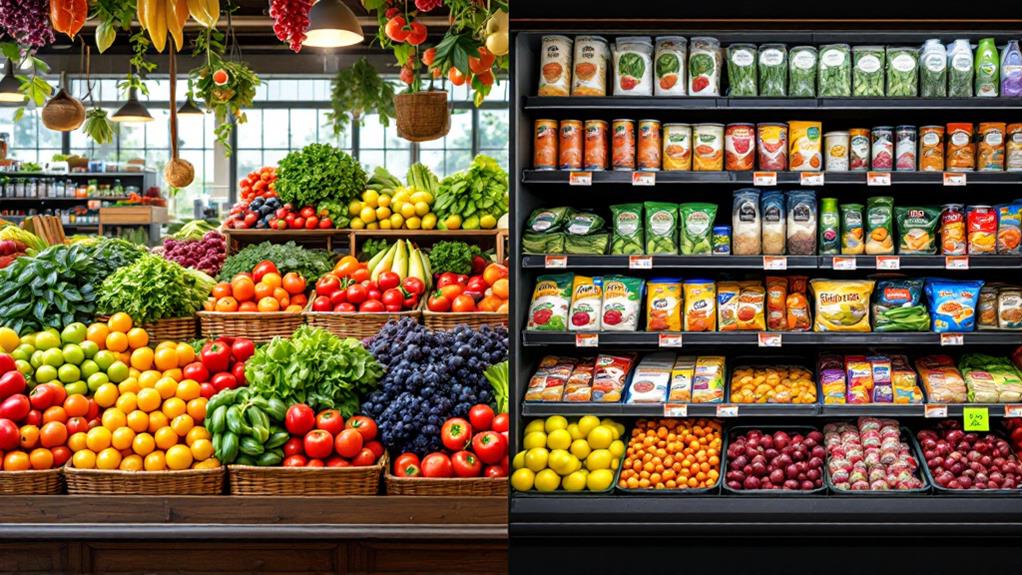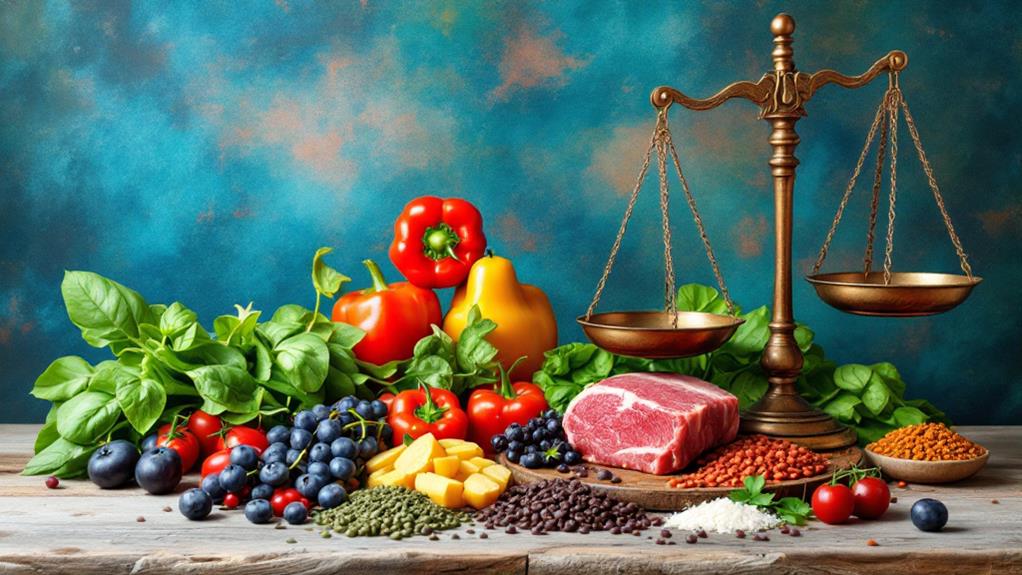Food: Too Good to Waste – Tips for Reducing Food Waste at Home
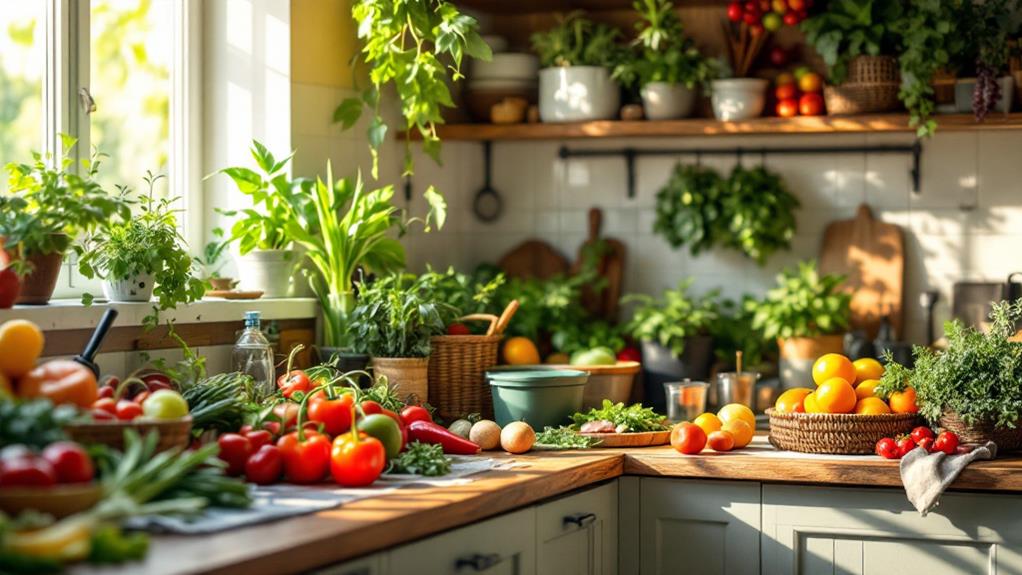
You can cut down on food waste and save money with just a few simple strategies. Start by planning meals based on what you already have at home and making a precise shopping list. Learn to interpret food date labels to avoid tossing safe-to-eat items. Get creative with cooking by using up overripe fruits or leftover veggies in new dishes like soups or smoothies. Store foods properly to extend their life, and consider donating untouched items to local food banks. Composting is another great way to put food scraps to good use. Uncover further practical tips that can help.
Importance of Reducing Food Waste
Reducing food waste at home is crucial for several reasons. You play a significant role in this effort, as nearly 40% of the 66 million tons of food wasted in the U.S. in 2019 came from households. By focusing on food waste prevention, you can make a substantial difference. Not only does reducing food waste help the environment by cutting down on greenhouse gas emissions—58% of landfill methane emissions come from decomposing food waste—but it also saves you money. The average family of four wastes about $1,500 annually on uneaten food, so smart shopping and mindful consumption can lead to significant savings.
Additionally, the economic impact of food waste in the U.S. reaches $161 billion each year. By reducing household food waste, you contribute to lessening this financial strain. Utilizing food scraps creatively and planning meals around what you already have can further minimize waste. Beyond economic benefits, reducing waste can also help address food insecurity, as the calories lost daily from wasted food could support those in need. By taking these steps, you're not just saving money but also helping to create a more sustainable and equitable food system.
Effective Meal Planning
To tackle the challenge of food waste at home, embracing effective meal planning is a powerful strategy. The average family of four wastes around $1,500 annually on uneaten food. By planning your meals, you can considerably reduce food waste. Start by creating a detailed shopping list based on your meal plans. This helps avoid unnecessary purchases and prevents overbuying, guaranteeing that food is used before it spoils.
Before heading to the store, check your pantry items. This simple step prevents duplicate purchases and ensures you're using what you already have. When you plan meals, include specific quantities on your shopping list to align with portion sizes. This way, you purchase only what you need, minimizing leftovers and guaranteeing food isn't wasted.
Utilize resources like interactive meal prep tools and USDA materials to improve your meal planning effectiveness. These tools can help you organize and prepare your meals more efficiently, leading to less waste. By staying organized and mindful of what you buy and how you prepare it, you'll find that effective meal planning not only saves money but also contributes to a more sustainable household.
Smart Shopping Strategies
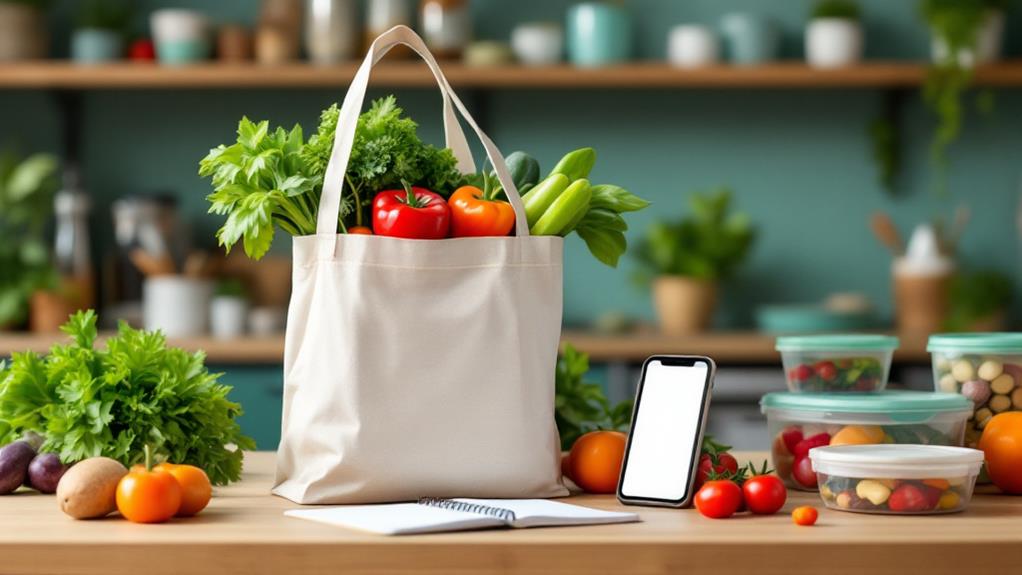
In the matter of decreasing food waste, smart shopping strategies are vital tools. By implementing a meal plan and crafting a detailed shopping list, you can avoid impulse buys and help reduce the shocking 40% of food grown in the U.S. that goes uneaten. Before heading out, check your pantry to avoid buying duplicates, which can lead to unnecessary spending and waste. Remember, the average family of four wastes about $1,500 annually on uneaten food.
Focus on buying specific quantities and consider portion sizes to prevent over-purchasing, which often results in spoilage. This approach not only helps minimize your food waste but also guarantees you're spending wisely. Welcome imperfect produce, as these items are typically discarded due to superficial blemishes but are perfectly good to eat. By choosing them, you save money and contribute to reducing waste.
While it's significant to be mindful of food date labels, understanding them in detail is a topic for another section. For now, focus on these smart shopping tips to do your part in preventing food waste at home. Every small change you make contributes to a larger impact on reducing total food waste.
Understanding Food Date Labels
Food date labels can be a source of confusion, yet understanding them is crucial for minimizing household waste. You might often wonder what those "sell-by", "use-by", and "best-by" dates truly mean. By understanding food date labels, you can reduce food waste considerably. The "sell-by" date helps retailers manage inventory and doesn't necessarily mean the food isn't safe to eat afterward. The "use-by" date indicates when the product is at its peak quality, but it doesn't imply that consuming it after this date is unsafe. Likewise, "best-by" dates refer to the period when the food is at its best flavor or quality.
Misinterpreting these labels contributes to approximately 20% of household food waste, leading you to throw away perfectly good food. To combat this, keep in mind that many products remain safe after the "best-by" date. Utilize resources from the FDA and USDA to gain a deeper understanding of these labels, helping you reduce food waste and save money. By being informed, you can minimize disposal and guarantee food safety in your home, contributing to a more sustainable and efficient household. Accept this knowledge to make better decisions and keep waste at bay.
Creative Cooking Techniques
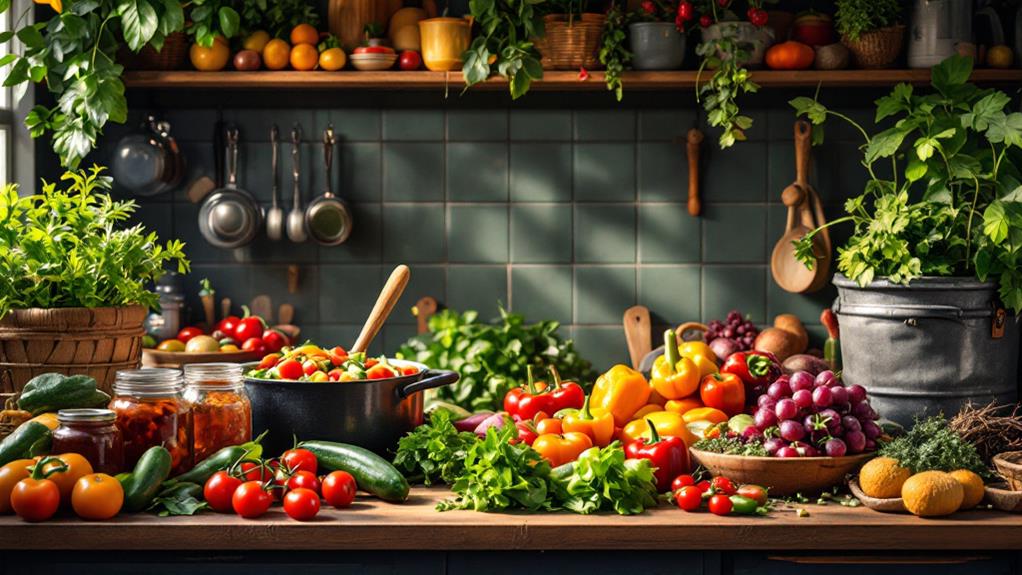
Transform your kitchen into a hub of creativity by embracing cutting-edge cooking techniques that reduce food waste. It's easier than you think to turn potential waste into culinary gems. By using these methods, you'll not only cut down on food scraps but also uncover new flavors and textures in your meals.
- Smoothies with Overripe Produce: Overripe fruits and vegetables are perfect for smoothies. Their texture blends seamlessly, and their flavor shines, turning what might be discarded into a delicious drink.
- Leftover Vegetables in Soups and Stews: Don't toss leftover vegetables. Instead, incorporate them into soups, stews, or stir-fries. This not only amplifies flavor and nutrition but also guarantees those veggies don't end up as waste.
- Homemade Sauces and Dressings: Experiment with herbs and veggies nearing spoilage by creating homemade sauces or dressings. This way, nothing goes to waste, and your meals get a fresh, flavorful uplift.
- Repurposing Stale Bread: Transform stale bread into croutons or breadcrumbs. Store them for future use, turning what could be waste into a valuable ingredient for your dishes.
Proper Food Storage Tips
Your kitchen can be a sanctuary of freshness when you master the art of proper food storage. By implementing Smart Storage techniques, you can greatly reduce food waste and keep your fruits and vegetables at their best. Start with your refrigerator's drawers: store vegetables in high humidity sections to maintain moisture and prolong freshness, while fruits thrive in low humidity to prevent overripening.
Be mindful of ethylene-producing fruits like apples and bananas. Keep them separate from other produce to prevent spoilage and extend the life of more sensitive items. This simple step can reduce wasted food dramatically. As for berries, resist washing them until you're ready to eat; excess moisture encourages mold growth and speeds up deterioration.
Potatoes prefer a cool, dry, and dark environment. Store them properly to prevent sprouting and maintain their quality longer. Don't forget about grains—airtight containers are your allies. Label them with contents and dates to monitor freshness and guarantee proper organization.
These Storage Tips are crucial for reducing food waste and keeping your kitchen stocked with fresh ingredients. With proper food storage, you'll enjoy prolonged freshness and fewer trips to the store.
Utilizing Leftovers Wisely

Regarding tackling food waste, utilizing leftovers wisely is a game-changer. With 60% of food waste happening at home, repurposing leftovers can greatly reduce this issue. Here's how you can make the most of what's left in your fridge:
- Cook Intentionally: When you cook larger portions, plan to transform those leftovers into new meals. This approach not only reduces food waste but also adds variety to your weekly meal prep. Think of turning last night's roast chicken into a tasty chicken salad or soup.
- Get Creative with Overripe Foods: Instead of tossing overripe fruits, blend them into smoothies or bake them into muffins. This creative use of leftovers keeps your meals exciting and your waste minimal.
- Practice 'Oldest In, Oldest Out': Organize your fridge so that older items are used first. This simple method of food waste prevention guarantees you're using what you have before it spoils, effectively reducing waste.
- Conduct Mini Waste Audits: Regularly check what leftovers you're throwing out. These audits can highlight patterns in your food waste, helping you adjust your meal prep and shopping habits, ultimately saving you money—potentially over $1,600 annually.
Embrace these tips to effectively manage your leftovers and save money.
Food Donation Options
Contributing to a more sustainable future, food donation options offer a practical way to combat both waste and hunger. When you donate untouched, nutritious food to food banks, you're not just reducing food waste; you're also helping to alleviate hunger in your community. With around 66 million tons of food wasted in 2019 alone—40% of which came from households—your contributions can make a significant difference. Food banks and shelters often accept not only canned goods but also fresh produce, dairy, and packaged items, as long as they're within their expiration dates.
In addition to traditional food banks, consider using community sharing platforms and gleaning groups. These creative channels facilitate the donation of excess food from backyard gardens or grocery stores, ensuring that surplus food efficiently reaches those facing food insecurity. In 2021, 10.2% of U.S. households experienced food insecurity, making your contributions even more vital.
Starting a Composting System
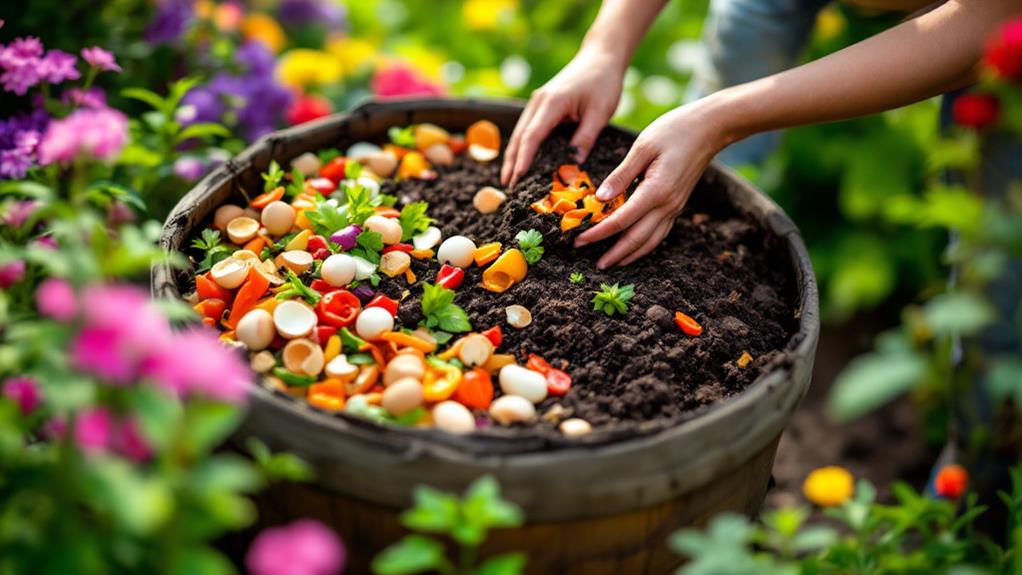
Starting a composting system at home is a practical way to greatly cut down on food waste while benefiting the environment. By composting food scraps like vegetable peels, coffee grounds, and eggshells, you divert organic material from landfills, where it contributes to 58% of methane emissions. Instead, you can create nutrient-rich compost to enrich your garden soil, promoting healthy ecosystems and supporting sustainable gardening.
To get started, consider these steps:
- Choose a Method: Decide between backyard compost bins, vermicomposting with worms, or compost tumblers. Each method has its own benefits and can be tailored to your space and resources.
- Gather Materials: Combine kitchen scraps with yard waste, such as grass clippings and leaves. This mix of green and brown materials creates a balanced compost pile.
- Maintain the System: Turn the compost regularly to aerate it and speed up decomposition. Keep the pile moist but not too wet to guarantee efficient nutrient cycling.
- Utilize Local Resources: If maintaining a compost system at home isn't feasible, take advantage of local drop-off sites for food scraps, like those in Saint Paul.
Community Involvement Initiatives
While managing food waste at home through composting is a rewarding step, engaging with community initiatives amplifies the impact. Community organizations and local governments partnering in "Food: Too Good to Waste" campaigns can greatly reduce household food waste, putting money back into your pocket. By involving educational institutions, you can also see food waste prevention integrated into K-12 and university curricula, ensuring the next generation is aware and active in sustainable practices.
Local food purveyors, such as restaurants and grocery stores, play an essential role in these initiatives. By sharing resources and strategies, they help minimize food waste across the entire food service industry. You can support these efforts by choosing businesses that prioritize sustainable practices. Furthermore, gleaning groups offer a fantastic way for you to get involved, by organizing community efforts to collect surplus produce from local farms. This not only prevents food waste but also alleviates food insecurity.
Participating in community composting initiatives is another impactful way to contribute. These programs provide workshops and resources, encouraging residents like you to adopt sustainable waste management. By joining these efforts, you help create a more resilient, responsible local food supply system.


